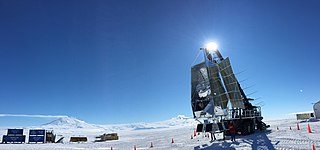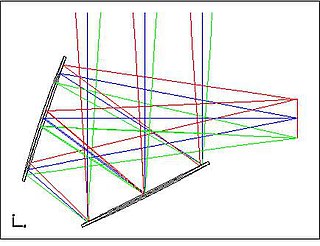
The cosmic microwave background, or relic radiation, is microwave radiation that fills all space in the observable universe. With a standard optical telescope, the background space between stars and galaxies is almost completely dark. However, a sufficiently sensitive radio telescope detects a faint background glow that is almost uniform and is not associated with any star, galaxy, or other object. This glow is strongest in the microwave region of the electromagnetic spectrum. The accidental discovery of the CMB in 1965 by American radio astronomers Arno Penzias and Robert Wilson was the culmination of work initiated in the 1940s.

The Large Millimeter Telescope (LMT), officially the Large Millimeter Telescope Alfonso Serrano, is the world's largest single-aperture telescope in its frequency range, built for observing radio waves in the wave lengths from approximately 0.85 to 4 mm. It has an active surface with a diameter of 50 metres (160 ft) and 1,960 square metres (21,100 sq ft) of collecting area.
Clover would have been an experiment to measure the polarization of the Cosmic Microwave Background. It was approved for funding in late 2004, with the aim of having the full telescope operational by 2009. The project was jointly run by Cardiff University, Oxford University, the Cavendish Astrophysics Group and the University of Manchester.

The South Pole Telescope (SPT) is a 10-metre (390 in) diameter telescope located at the Amundsen–Scott South Pole Station, Antarctica. The telescope is designed for observations in the microwave, millimeter-wave, and submillimeter-wave regions of the electromagnetic spectrum, with the particular design goal of measuring the faint, diffuse emission from the cosmic microwave background (CMB). Key results include a wide and deep survey of discovering hundreds of clusters of galaxies using the Sunyaev–Zel'dovich effect, a sensitive 5 arcminute CMB power spectrum survey, and the first detection of B-mode polarized CMB.

The Atacama Cosmology Telescope (ACT) was a cosmological millimeter-wave telescope located on Cerro Toco in the Atacama Desert in the north of Chile. ACT made high-sensitivity, arcminute resolution, microwave-wavelength surveys of the sky in order to study the cosmic microwave background radiation (CMB), the relic radiation left by the Big Bang process. Located 40 km from San Pedro de Atacama, at an altitude of 5,190 metres (17,030 ft), it was one of the highest ground-based telescopes in the world.

Spider is a balloon-borne experiment designed to search for primordial gravitational waves imprinted on the cosmic microwave background (CMB). Measuring the strength of this signal puts limits on inflationary theory.
The E and B Experiment (EBEX) was an experiment that measured the cosmic microwave background radiation of a part of the sky during two sub-orbital (high-altitude) balloon flights and took large, high-fidelity images of the CMB polarization anisotropies using a telescope which flew at over 42,000 metres (138,000 ft) high. The altitude of the telescope made it possible to reduce the atmospheric absorption of microwaves, which allowed massive cost reduction compared to a satellite probe, however, only a small part of the sky can be scanned and for a shorter duration than a typical satellite mission such as WMAP.

QUIET was an astronomy experiment to study the polarization of the cosmic microwave background radiation. QUIET stands for Q/U Imaging ExperimenT. The Q/U in the name refers to the ability of the telescope to measure the Q and U Stokes parameters simultaneously. QUIET was located at an elevation of 5,080 metres at Llano de Chajnantor Observatory in the Chilean Andes. It began observing in late 2008 and finished observing in December 2010.

BICEP and the Keck Array are a series of cosmic microwave background (CMB) experiments. They aim to measure the polarization of the CMB; in particular, measuring the B-mode of the CMB. The experiments have had five generations of instrumentation, consisting of BICEP1, BICEP2, the Keck Array, BICEP3, and the BICEP Array. The Keck Array started observations in 2012 and BICEP3 has been fully operational since May 2016, with the BICEP Array beginning installation in 2017/18.

POLARBEAR is a cosmic microwave background polarization experiment located in the Atacama Desert of northern Chile in the Antofagasta Region. The POLARBEAR experiment is mounted on the Huan Tran Telescope (HTT) at the James Ax Observatory in the Chajnantor Science Reserve. The HTT is located near the Atacama Cosmology Telescope on the slopes of Cerro Toco at an altitude of nearly 5,200 m (17,100 ft).
Calvin Barth Netterfield, known as Barth Netterfield, is a Canadian astrophysicist, and a Professor in the Department of Astronomy and the Department of Physics at the University of Toronto. He is a leading expert in the development of balloon-borne telescopes. These are astrophysical experiments that are lifted into the stratosphere by high-altitude balloons where they conduct observations that would be hindered by atmospheric interference if done on the ground. Netterfield is primarily known for his work in observational cosmology, specifically in developing instrumentation to observe the cosmic microwave background (CMB) radiation. Most notably, he was a key member of the instrument team for BOOMERANG, the experiment that made one of the first accurate determinations of the age, geometry, and mass-energy content of the universe. More recently, he has delved into the field of submillimetre astronomy and the physics of star formation, through his involvement with the BLAST telescope. Netterfield was featured prominently in BLAST!, a documentary film about the 2005 and 2006 flights of BLAST from Sweden and Antarctica.
The C-Band All Sky Survey (C-BASS) is a radio astronomy project that aims to map the entire sky in the C Band (5 GHz). It has been conducted on two radio telescopes, one operating in the Karoo in South Africa, the other at Owens Valley Radio Observatory in California.

The NIRSpec is one of the four scientific instruments flown on the James Webb Space Telescope (JWST). The JWST is the follow-on mission to the Hubble Space Telescope (HST) and is developed to receive more information about the origins of the universe by observing infrared light from the first stars and galaxies. In comparison to HST, its instruments will allow looking further back in time and will study the so-called Dark Ages during which the universe was opaque, about 150 to 800 million years after the Big Bang.

The Cosmology Large Angular Scale Surveyor (CLASS) is an array of microwave telescopes at a high-altitude site in the Atacama Desert of Chile as part of the Parque Astronómico de Atacama. The CLASS experiment aims to improve our understanding of cosmic dawn when the first stars turned on, test the theory of cosmic inflation, and distinguish between inflationary models of the very early universe by making precise measurements of the polarization of the Cosmic Microwave Background (CMB) over 65% of the sky at multiple frequencies in the microwave region of the electromagnetic spectrum.

The Simons Observatory is located in the high Atacama Desert in Northern Chile inside the Chajnator Science Preserve, at an altitude of 5,200 meters (17,000 ft). The Atacama Cosmology Telescope (ACT) and the Simons Array are located nearby and these experiments are currently making observations of the Cosmic Microwave Background (CMB). Their goals are to study how the universe began, what it is made of, and how it evolved to its current state. The Simons Observatory shares many of the same goals but aims to take advantage of advances in technology to make far more precise and diverse measurements. In addition, it is envisaged that many aspects of the Simons Observatory will be pathfinders for the future CMB-S4 array.

The QUIJOTE CMB Experiment is an ongoing experiment started in November 2012, and led by Rafael Rebolo López, with the goal of characterizing the polarization of the cosmic microwave background (CMB) and other galactic and extragalactic emission in the frequency range 10 to 40 GHz, at angular scales of 1°. These measurements will complement at low frequency and correct from galactic contamination those obtained by the Planck satellite from 2009 to 2013.

The Crossed Dragone Telescope is an off-axis telescope design consisting of a parabolic primary mirror and a large concave secondary mirror arranged so that the focal plane is at right angles to the incoming light. In this configuration the polarization of light is preserved through the optics.
In cosmological inflation, within the slow-roll paradigm, the Lyth argument places a theoretical upper bound on the amount of gravitational waves produced during inflation, given the amount of departure from the homogeneity of the cosmic microwave background (CMB).













